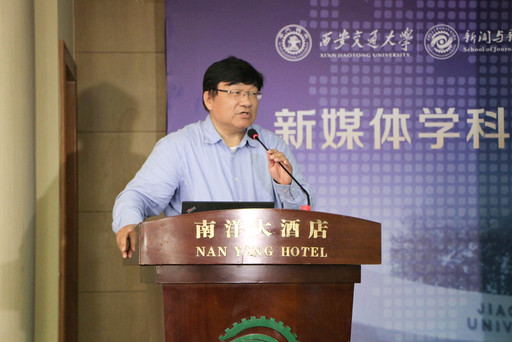
. > WHAT'S NEW > CONFERENCES
Promoting journalism talent cultivation in smart media age
Author : LU HANG Source : Chinese Social Sciences Today 2019-04-24

Yu Guoming, executive dean of the School of Journalism and Communication at Beijing Normal University, delivers a speech at a seminar on journalism talent cultivation. Photo: XI’AN EURASIA UNIVERSITY
With the progress of technologies like artificial intelligence, big data and new media, journalism talent cultivation faces unprecedented challenges and changes. An increasing number of universities and colleges are pushing forward integration and innovation among different disciplines based on the inheritance of traditional theories, fully leveraging the advantages of new media in terms of teaching methods, incorporating new media elements into discipline construction, and strengthening cooperation with the media industry, so as to find applications for theories and research results. On April 6, a seminar concerning the integration of disciplines and journalism talent cultivation was held in Xi’an. Scholars and experts carried out in-depth discussions on related issues.
Our media education has produced fruitful results through proactively adapting to the new media communication environment, connecting traditional journalism education with new media platforms, and simultaneously promoting theoretical teaching and application. Li Mingde, dean of the School of Journalism and New Media at Xi’an Jiaotong University, said that discipline integration is the fountainhead of innovation. It has become an increasing tendency for journalism talent cultivation to integrate disciplines, advance traditional journalism teaching’s development with new media, combine journalism teaching and practice, push ahead with cross-disciplinary cooperation, and emphasize in new media education talented journalist’s career orientation and the design of the discipline’s system.
Yu Guoming, executive dean of the School of Journalism and Communication at Beijing Normal University, said that different from the traditional communication mode of one to many, the one-to-one mode is more common in the internet era, with connection, coordination and opening up rather than competition becoming the main features of communication and the major mode of value realization. To promote the industrial chain and value chain of journalism and communication, we cannot rely only on our own efforts but must seek cooperation with open-mindedness and coordination.
Utilizing big data has become a basic skill for high-performing workers in journalism; therefore, the School of Journalism and Communication should strengthen students’ skills in collecting, analyzing and utilizing data. Hong Junhao, a professor from the Department of Communication under the State University of New York, said that for journalism and communication, big data includes all information either ordered or chaotic, such as words, maps, images, video and audio. The “big” in big data signifies huge volume and rapid processing speed. Big data has exerted multifaceted active influences on journalism and communication; however, data itself is not news. Hong added that talented journalists should be equipped with three basic skills, that is, storytelling, the ability to raise high-quality questions, and the ability to conduct unique analysis, which cannot be replaced by big data but must be obtained through training and practice.
Edited by Su Xuan
Ye Shengtao made Chinese fairy tales from a wilderness
Ye Shengtao (1894–1988) created the first collection of fairy tales in the history of Chinese children’s literature...
-
How northern ethnicities integrated into Chinese nation
2023-09-18
-
Mogao caves
2023-09-12
-
Mogao Grottoes as ‘a place of pilgrimage’
2023-09-12
-
Time-honored architectural traditions in China
2023-08-29
-
Disentangling the civilizational evolution of China
2023-08-28
-
AI ethics in science fiction
2023-08-23













 2011-2013 by www.cssn.cn. All Rights Reserved
2011-2013 by www.cssn.cn. All Rights Reserved